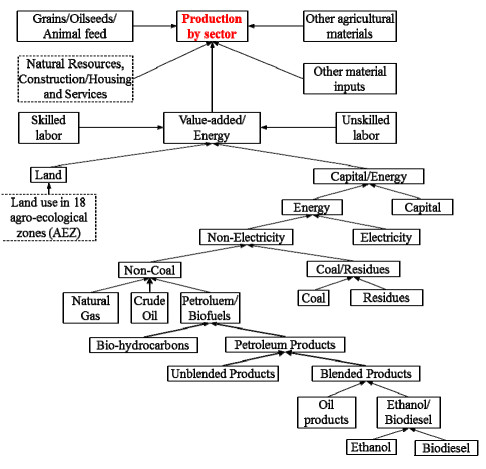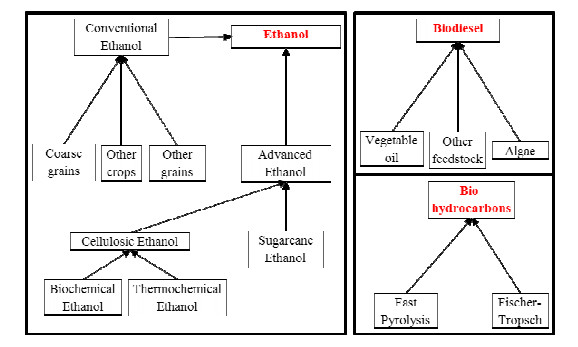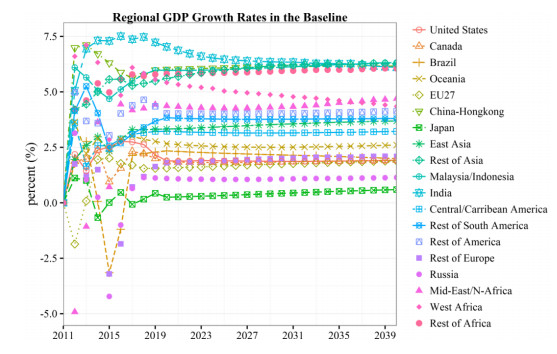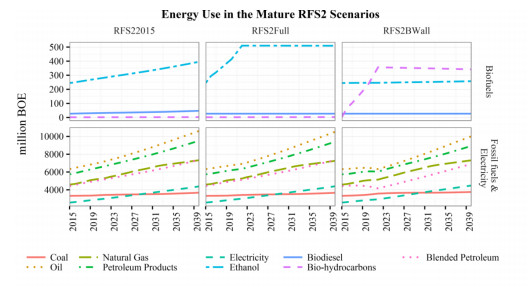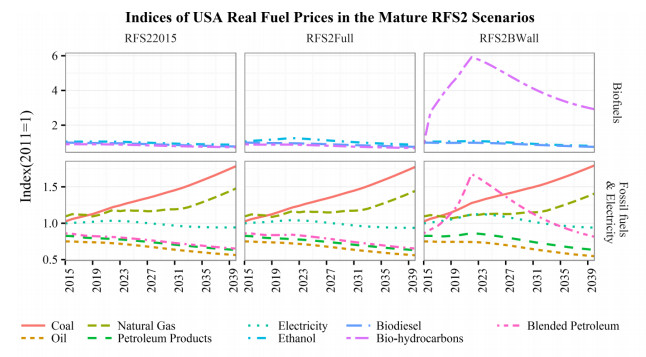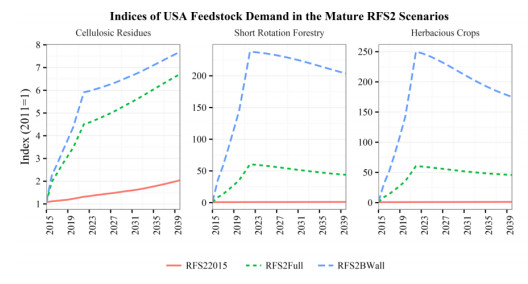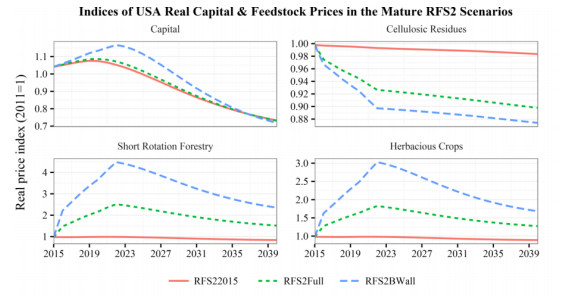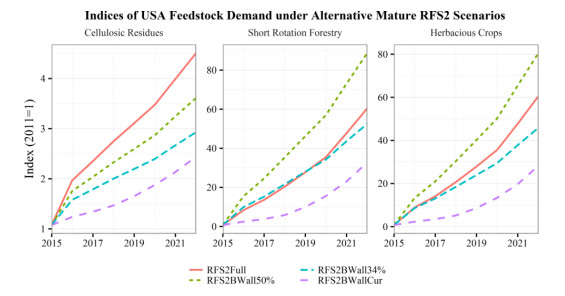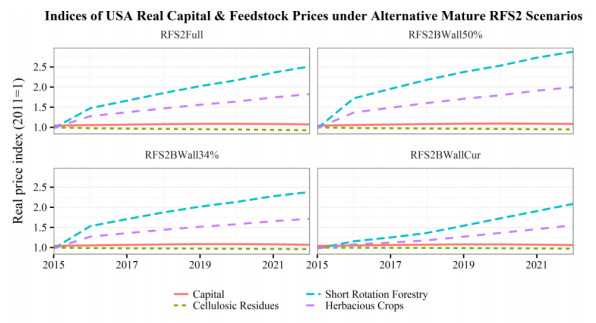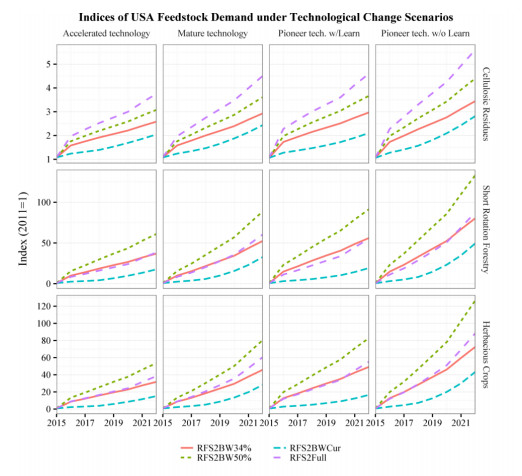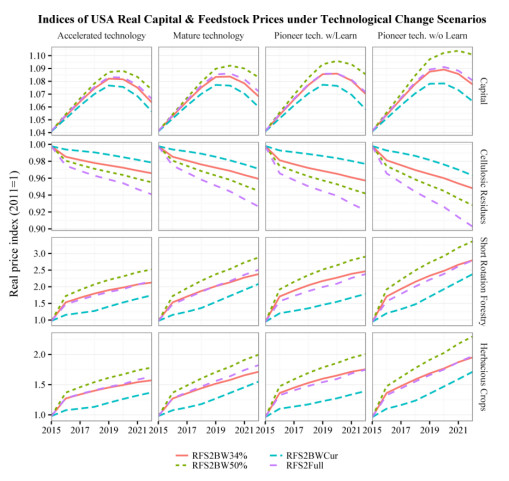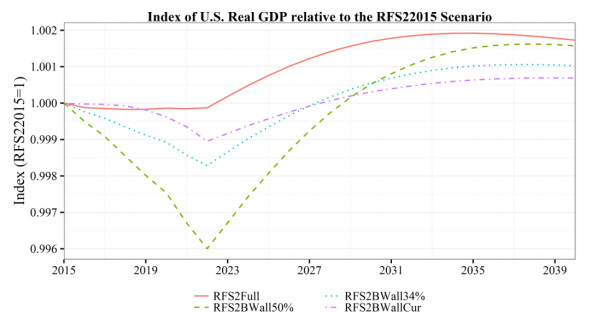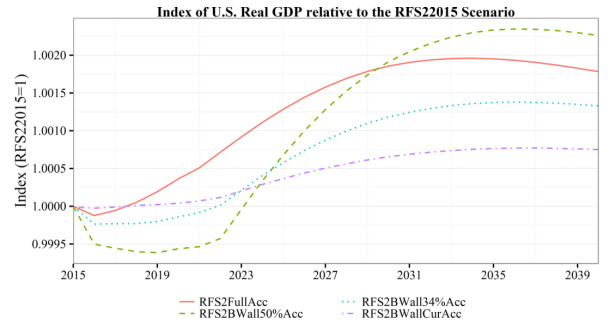Energy market conditions have shifted dramatically since the USA renewable fuel standards (RFS1 in 2005; RFS2 in 2007) were enacted. The USA has transitioned from an increasing dependence on oil imports to abundant domestic oil production. In addition, increases in the use of ethanol, the main biofuel currently produced in the USA, is now limited by the blend wall constraint. Given this, the current study evaluates alternative biofuel deployment scenarios in the USA, accounting for changes in market conditions. The analysis is performed with a general equilibrium model that reflects the structure of the USA biofuel market as the transition to advanced biofuels begins. Results suggest that ethanol consumption would increase, albeit slowly, if current biofuel deployment rates of about 10% are maintained as persistently lower oil prices lead to a gradual increase in the consumption of liquid transportation fuels. Without the blend wall constraint, this study finds that the overall economic impact of a full implementation of the USA RFS2 policy is largely neutral before 2022. However, the economic impacts become slightly negative under the blend wall constraint since more expensive bio-hydrocarbons are needed to meet the RFS2 mandates. Results for a scenario with reduced advanced biofuel deployment based on current policy plans show near neutral economic impacts up to 2027. This scenario is also consistent with another scenario where the volume of bio-hydrocarbons deployed is reduced to adjust for its higher cost and energy content relative to deploying the mandated RFS2 advanced biofuel volumes as ethanol. The important role of technological change is demonstrated under pioneer and accelerated technology scenarios, with the latter leading to neutral or positive economic effects up to 2023 under most blend wall scenarios. All scenarios evaluated in this study are found to have positive long-term benefits for the USA economy.
1.
Introduction
The COVID-19 epidemic has profoundly impacted social and professional situations in several ways. Policies that enforce social separation, mandatory lockdowns, periods of seclusion, worry about falling ill, suspension of productive activity, loss of income, and fear of the future all have an impact on the mental health of both residents and employees [1]. The agri-food sector has not been immune to these impacts, as the pandemic has significantly changed our perceptions, purchasing habits, and consumption patterns. COVID-19 often referred to as the "Black Swan Event", which happens as a surprise incident and is not thought to be commonly found. These events are distinguished by their most outstanding incompatibility and acute effects [2]. In the immediate period, the pandemic impacted the agri-food sector through various labor-related challenges, such as decreased availability of workers due to illness and quarantine protocols. Additionally, factories were forced to shut down, leading to food shortages in stores and financial strain on businesses [3]. Looking at the long-term effects, According to Galakinis et al., the pandemic has influenced the entire food sector across four key areas: Food safety, bioactive food ingredients, food security, and sustainability [4].
Maintaining food production during COVID-19 was difficult because cases in the agricultural food production, slaughterhouse, and food processing industries tended to cluster [5]. The emergence of these issues within the food industry in the new era has exposed operational challenges in maintaining a balanced food supply while adhering to social distancing measures. The COVID-19 pandemic has established a new standard for society, creating a climate of uncertainty that has prompted numerous companies to adapt and sustain their operations within the market [6]. Work practices have transformed remote operations, encompassing telecommuting, utilizing digital communication platforms, and adopting Internet and Communication Technologies (ICT) [6].
As per [7], 2020 and 2021 witnessed the unrelenting assault of the COVID-19 pandemic, resulting in extensive global consequences that resonated throughout all levels of life. These included sectors like farming, manufacturing, transportation, and economic losses, limiting the population's access to food, reducing their freedom of movement, and hindering various activities. Agribusiness companies, rural and urban consumers, households relying on agricultural workers, and farms suffered significant economic setbacks due to the COVID-19 disturbances, according to [8], who studied the entire agri-food system in Myanmar. The agri-food sector has been affected by several crises, such as supply interruptions brought on by restrictions on transportation, domestic and international demand shocks, and financial restraints. [9] discovered that internal distribution networks in India were impacted by movement limitations, transportation problems, and reverse labor migration. As a result, the wholesale and retail prices of various items, including pulses, wheat, milk, and vegetables, increased. Important rice exporters like Thailand and Vietnam experienced economic distortions that increased global prices, harming African nations that depend significantly on imported food [10]. The Impact of the COVID-19 epidemic on food prices varies. Food affordability was limited in many countries due to price increases brought on by disruptions in international trade [11]. For instance, [12] discovered that the pandemic significantly raised the cost of vegetables in Ethiopia, which affected urban households' diets and means of subsistence. According to [13], countries that depend on imports experienced the highest rise in food prices. For instance, between February 2020 and July 2020, countries like Guyana, Venezuela, and Zambia saw a considerable increase (29%, 47%, and 49.8%, respectively) in local food prices compared to developed nations such as Switzerland, the United Kingdom, and Canada that experienced stable or only moderate increases.
Qualitative research conducted in Latin America and the Caribbean reveals that food loss and waste resulting from COVID-19-related disruptions to the transport system was 49%, with an additional 18% attributed to disruptions in the food trade [14]. Due to a lack of transportation, over 5000 tonnes of weekly vegetables from the Bolivarian Republic of Venezuela stayed in the fields. A total of 37.75 per cent of Bangladesh's labor force is employed in agriculture, which will generate 12.65 per cent of the country's GDP (128.57 million USD) in 2020. The agricultural sector is essential to achieving macroeconomic objectives like employment, food security, poverty reduction, and human resource development. In an experiment in 2020, BRAC found that farmers suffered a significant loss of more than 56,536 thousand BDT during the shutdown from March to May. According to [15], among smallholder farmers in Senegal, 77.7 per cent of respondents reported having less access to inputs, 70.3 per cent reported having less ability to plant crops during the planting season, 57.1 per cent reported having less ability to rent farm machinery, and 69.2 per cent reported having fewer yields.
According to the 1966 International Covenant on Economic, Social and Cultural Rights, which became effective in 1976, food security is acknowledged as a fundamental human right [16]. The eradication of hunger requires Sustainable Developmental Goal -2 targets and indicators aligned with the four pillars of food security: availability (having available sufficient quantities of food whose continued production also depends on a healthy environment), access (having the economic and physical means to obtain a nutritious diet), utilization (having adequate dietary intake and the ability to absorb and use nutrients in the body), and stability (ensuring the other three pillars consistently) [17,66].
The COVID-19 pandemic has caused unparalleled disruptions in several industries, with the agri-food sector suffering a significant blow [18]. Despite the agri-food sector's typically resistant nature to economic cycles, the pandemic has resulted in substantial shocks to agricultural and food systems worldwide, leading to an unprecedented supply chain disruption in the agri-food industry [19]. This extraordinary upheaval has affected the entire agri-food system, from production and processing to distribution and consumption, posing unique issues that call for creative and flexible solutions [20]. How the pandemic and the agri-food sector interact has sparked severe worries about how it may affect the agri-food system's future resilience and global food security [21]. Examining the complex effects of the pandemic on food production, distribution, consumption trends, and the stability of the agri-food supply chain as a whole has become essential as it has spread [22]. The COVID-19 pandemic has caused severe problems for the agri-food industry, impacting supply chains, global economics, and food security. To ensure the resilience and sustainability of the agri-food sector in the post-pandemic age and the future of food security, it is imperative to thoroughly analyze the pandemic's ramifications and devise comprehensive strategies to address its impact.
An important area of study that demands in-depth examination and knowledge is agri-food security in post-pandemic conditions. The COVID-19 pandemic exposed flaws in the agri-food system, such as supply chain breakdowns, a labor shortage, and problems with food access, through its spread and consequences on the world's population. According to the OECD, the COVID-19 pandemic and related lockdown measures caused significant supply chain disruptions in the agriculture and food sectors in 2020 [23]. In light of the global pandemic aftermath, examining the effects on the agri-food sector and understanding how they may affect post-pandemic recovery and future food security is imperative. As such, a thorough assessment of the consequences on the agri-food sector is urgently needed [24]. Here, we seek to address the gap in our understanding of the multifaceted challenges and opportunities faced by the agri-food sector during and after the COVID-19 pandemic. Our aims are to provide a nuanced understanding of the disruptions faced by the industry during the pandemic, assess the implications for post-pandemic recovery, and critically examine the potential consequences for the future of global food security. By synthesizing existing research, identifying gaps in knowledge, and offering evidence-based insights, we seek to contribute to developing informed strategies that enhance the resilience, sustainability, and adaptability of the agri-food sector in a post-COVID-19 world. To achieve this objective, we address the following research questions:
1. What Impact does the pandemic have on Global Food Security?
2. Did consumer food consumption change during the pandemic and post-pandemic era?
3. What is the food insecurity rate in countries during the COVID-19 pandemic?
4. What is the Future of Food Security and Resilience in Agri-Food Systems in post-pandemic?
2.
Methodology
We use a systematic literature analysis to evaluate pertinent articles discussing the effects of the COVID-19 pandemic on the agri-food sector and potential post-pandemic actions for increased food security. The PRISMA 2020 checklist for systematic literature was used in this study [25]. The PRISMA framework provides a standardized approach incorporating meticulous guidelines for conducting systematic literature reviews [26]. This systematic review involved the development of an analytical grid, charts, and maps to effectively organize relevant information extracted from selected articles and identify research gaps.
2.1. Search strategy
A comprehensive search was conducted in prominent databases, including Scopus and Google Scholar, to identify scholarly articles addressing the Impact of COVID-19 on agri-food security in the post-pandemic period and its implications for the future of food security (Table 1). Scholarly peer-reviewed articles were only selected because of their rigorous evaluation process by experts in the field before they were published. The search yielded several relevant articles that provide valuable insights into the multifaceted challenges faced by the agri-food sector during the pandemic and its aftermath. The review utilized the Scopus database to retrieve pertinent articles and high-quality papers. Additionally, Google Scholar was used to identify relevant papers addressing our research inquiries. We expanded our range of keywords and devised a thorough search query by employing Boolean operators, truncation, wildcard entries, and phrase searches within the two main databases: Scopus and Google Scholar. Scopus allows users to conduct basic and advanced searches, refining their results based on various criteria such as document type, date, subject, author, and recent publications, all while utilizing Boolean operators. Our research was enhanced using the Boolean operator "AND" in Google Scholar to refine our search. Additionally, we manually conducted a Google search and reviewed the first 20 results to identify relevant articles and findings related to our research inquiries, following the methodology outlined by [27]. This approach allowed us to gather pertinent scholarly articles that met the academic standards for our study. The search utilized a combination of keywords such as "agri-food", "agro-food", "agri-food security", "agri-food security", "post-pandemic", "agri-food production", "COVID-19", "food insecurity", "food security", "global food security", "consumer consumption", "resilience", "food consumption". Additionally, searches were expanded to include keywords such as "agri-food supply", "agro-food supply", "agricultural food production", "agro-food system", "agricultural food system", "sustainable agriculture", and "lockdown" to ensure a comprehensive exploration of the topic.
2.2. Selection process
A total of 64 articles were identified through the initial search using the designated keywords. A second search was conducted to gain insight into the research topic and better understand our research question. This yielded a total of 45 articles, making up 109 articles. Duplicate articles were removed, while the articles were also screened based on their titles and abstracts to assess their relevance to the research topic. After this process, articles with no similarity with the research topic were screened out. Eighty-one papers remained for further evaluation, indicating the first exclusion stage. The 81 selected papers were then subjected to a thorough examination of their full texts. The methodology, results, and discussion sections were carefully reviewed to determine their suitability in addressing the research questions. After applying the exclusion criteria, 37 papers were deemed relevant and included in the systematic literature review. Figure 1 shows the detailed PRISMA flow diagram of the literature search.
2.3. Inclusion and exclusion criteria
Articles that were conference papers unrelated to food security in the post-pandemic context, books, non-English articles or duplicates were excluded from the final selection (Table 2). Articles that met the inclusion criteria at various stages were considered for analysis. The methodology, results, and discussion sections were carefully reviewed to determine their suitability in addressing the research questions. This represents a total of 37 articles. Only articles published between 2021–2023 were considered for inclusion. Academic publications published in peer-reviewed journals are chosen because they undergo a rigorous review procedure by subject matter experts. This procedure guarantees that the study techniques and results adhere to scholarly requirements [28].
3.
Result
The findings of the review are presented in three distinct sections. The initial section encompasses study descriptors, such as publication year and location of study. The subsequent section provides literature classification, including methodology, thematic categorization and resilience of the agri-food sector to the Covid-19 pandemic and future occurrence.
3.1. Descriptive studies
Figure 2 illustrates the publication years of the articles under review from 2021 to 2023. Only six of the 37 reviewed articles were published in 2023, thirteen in 2022, and eighteen in 2021. During this review period, 2023 has the lowest publications, indicating a potential shift beyond the COVID-19 pandemic worldwide. According to the OECD report titled "The territorial impact of COVID-19: Managing the crisis across levels of government, " the number of COVID-19-related articles published in academic journals peaked in 2020 and 2021 but has since declined. This observation suggests that the global research community gradually redirects its attention from COVID-19 to other subjects [29].
Table 3 depicts the countries where studies related to our research questions were conducted. Specifically, South Africa, Brazil, Nigeria, the USA, India, and Sub-Saharan Africa each hosted two research endeavours. Additionally, nine studies lacked a specific location designation and were categorized as global. Notably, four studies [30,31,32,33] were characterized as cross-study investigations involving research conducted in more than one country.
3.2. Literature classification
Figure 3 illustrates the research methodologies utilised in the study. Eighteen studies adopted a qualitative approach, while nineteen opted for a quantitative methodology. Examining the distribution of articles by methodology provided valuable insights into how the research questions were addressed. Qualitative studies contributed answers regarding resilience and the future of food security post-pandemic. In contrast, quantitative studies yielded empirical results on the impact of the pandemic on the agri-food sector.
In Table 4, the articles are thematically categorized, and the food or agri-food systems have the highest number of articles. Covering a series of market and non-market activities, this category spans land preparation to consumption. As a result, most articles belong to this category, emphasizing its role as one of the agricultural units most significantly affected by the COVID-19 pandemic. Following closely, food security claims the second-highest number of articles. This category includes articles that investigated at least one of the four dimensions of food security. The remaining thematic classifications are elaborated upon below.
The examined articles underscore various resilience measures that address future pandemic occurrences akin to COVID-19. The list of these resilience measures and corresponding articles is presented in Table 5 below.
Based on the deductions drawn from thematic categorization in Table 4, it becomes evident that the agri-food production sector (with 12 articles) and the agri-food marketing sector (with six articles) exhibited the highest frequency. This finding can be attributed to the substantial impact experienced by these sectors within the agri-food industry during the pandemic, which was characterized by interrupted production processes and disrupted agri-food distribution.
4.
Discussion
In the post-pandemic era, ensuring agri-food security becomes of utmost importance due to the potential disruptions and challenges faced by agricultural and food systems during the pandemic. These disruptions can arise from various factors, such as supply chain interruptions, labor shortages, shifts in consumer behavior, market instability, and the impact of the pandemic on the agricultural sector. The 37 reviewed articles have different objectives. However, they all provide a comprehensive overview of the disruption of COVID-19 on the agri-food sector and its implication for future food security post-pandemic. We aim to review the following research questions.
4.1. What impact does the pandemic have on global food security?
The COVID-19 pandemic has significantly impacted global food security. This effect has been influenced by several factors, such as changes in consumer behaviour and economic instability, as well as disturbances in food production, supply chains, and distribution networks. COVID-19 was reported to significantly affect agriculture in two major aspects: Food supply and demand (FAO 2020). The pandemic highlighted existing inequalities and vulnerabilities in food systems. Developing countries, small-scale farmers, and marginalized populations have faced heightened challenges in coping with the impacts of the crisis. [45] conducted a study using a global economy-wide model with detailed disaggregation of agricultural and food sectors and developed a business-as-usual baseline for 2020 and 2021 called "But-for-COVID" (BfC). The results revealed that food insecurity worsened before the COVID-19 pandemic, with a noticeable upward trend. The pandemic significantly intensified this trend, particularly in 80 low- and middle-income countries, with the most substantial Impact observed in large Asian countries like India, Bangladesh, and Pakistan. Sub-Saharan African, Latin American, and Caribbean nations also experienced a notable rise in food insecurity. In 2020, the surge in food insecurity was predominantly attributed to the effects of the COVID-19 pandemic. However, in 2021, about half of the continued deterioration in food security is attributed to long-term trends, indicating a less severe impact of the pandemic than in 2020. The uneven recovery in 2021 suggests that while the pandemic still plays a role, long-term trends contribute more significantly to ongoing food insecurity. [52] study used data from four western provinces in Congo on 1339 households. Their results show that 80% of households experienced an increase in food prices, 61% a noticeable decrease in food availability, and 54% a reduction of dietary diversity. Due to changes in food availability, dietary diversity, and food accessibility imposed by the COVID-19 outbreak, > 70% of households experienced either a decrease in the consumption of meat, milk, fish, and cereals or an increase in their consumption of traditional vegetables. In addition, [50] (2023) highlighted that in 2020, about 23.6% of South Africans experienced moderate to severe food insecurity, while 14.9% experienced severe food insecurity. Results from these studies highlighted the significant impacts of the COVID-19 pandemic food security on the four dimensions of food security: availability, accessibility, utilization and stability.
Regarding country-specific [62], they asserted that the pandemic has affected the national agri-food availability and accessibility in Malaysia. They further claimed that the COVID-19 pandemic had caused global food security and safety concerns. During the pandemic, the agri-food chain network was noticeably interrupted. The restrictions the governments had imposed on the mobility of labour and the tightening of import and export policies had impacted the drastic decline in agricultural production. [34] argued that the pandemic impacts the food systems, potentially affecting food security in India. They claimed that food security has also been affected since the pandemic disrupted the food system.
Regarding the effect of COVID-19 on crop production, [35] pointed out that COVID-19 created significant bean production challenges across the sub-Saharan regions among farmers, including low access to seed, farm inputs, hired labour, and agricultural finance. They also showed that COVID-19 threatens to reverse gains made in the achievement of Sustainable Development Goals number 1 and 2.
[30] claimed that more than two-thirds of the respondents in their study experienced income shocks due to the COVID-19 crisis. Food security and dietary quality worsened, as measured by the food insecurity experience scale and the frequency of consumption of nutritionally rich foods. However, [54] insisted that the factor that most negatively affects food security during the COVID-19 pandemic is the same as the most profound structural problem of global food security: Low income.
4.2. Did consumer food consumption change during the pandemic and post-pandemic era?
The COVID-19 pandemic has significantly affected consumer food consumption behavior, preferences, and priorities. In [31], 15–42% of their study participants from Denmark, Germany, and Slovenia changed their consumption frequency during the pandemic compared to before. In all the study countries, the food categories with the highest rates of change were frozen, canned, and cake and biscuits; among the food categories with lower rates of change were bread, alcoholic drinks, and dairy products. People across all three countries shopped less frequently during lockdown, and there was an overall reduction in the consumption of fresh foods but an increase in food consumption with a longer shelf life in Denmark and Germany. [36] agrees with [31], claiming that the pandemic has widely affected diet, food shopping, preparation, and use.
The changes in consumer food consumption habits are expected to continue into the post-pandemic period. In the coming years, it is projected that the convenience of online buying, health awareness, and a greater emphasis on home cooking will influence consumer preferences. Though [37] reiterated that it is too premature to give definite answers as to what food choice motives in the post-COVID-19 era will be like. The change in consumer food consumption regarding business and dining was discussed by [38]; they argue that dining rooms were forced to close, many food services had to resort to innovation to survive, and many added deliveries and adopted the dark kitchen models in one of their many forms. They further discussed that it is expected that the demand for delivery, dark kitchens, and the adoption of technological solutions, for example, contactless payment, will remain in the post-pandemic scenario. Contrary to the common belief that the lockdown had adverse effects solely on people's dietary habits, it was observed that there was a significant increase in the consumption of raw vegetables, whole grains, and water [39]. [40] claimed that consumers reduced their shopping trips to markets and started to use delivery services and shopping platforms during the pandemic. Basic animal, vegetable, and bakery products are being preferred during this period, in addition to economical packaging and products. Brazilians also indicated they are more concerned with food safety and hygienic practices.
4.3. What is the food insecurity rate in countries during the COVID-19 pandemic?
The impact of food insecurity exhibits variations among countries, contingent upon their pre-existing levels of food security, economic circumstances, and the efficacy of their social safety nets. Our findings indicate that the COVID-19 pandemic had a discernible impact on various agricultural sectors, as revealed through the thematic analysis of the reviewed articles. Among these sectors, the food systems emerged as the most significantly affected. A significant proportion of the examined literature concentrating on food insecurities during the pandemic predominantly focuses on developing countries, particularly African nations. A study by [32] on "Food insecurity during the first year of the COVID-19 pandemic in four African countries" Burkina Faso, Ethiopia, Malawi, and Nigeria, found that the sharp increase in food insecurity during the early months of the pandemic with a subsequent gradual decline. They found that food insecurity increased more in rural than urban areas relative to pre-pandemic data within the four countries. The rise in COVID-19 levels negatively impacts all four indicators of food security without exception, which are food accessibility, food availability, food utilization, and stability [56]. Their study showed that the average dietary energy supply adequacy was negatively associated with COVID-19 cases. This means that as COVID-19 cases rise, the energy supply adequacy declines. An increase in COVID-19 cases is associated with a rise in the proportion of children affected by wasting. This, in turn, implies that COVID-19 is associated with worsening food utilisation. Utilization, they ascertained that COVID-19 results in food supply variability due to changes in production, trade, government policies and distribution.
[57] pointed out that the COVID-19 lockdown was associated with an important reduction in food security, decreasing stepwise from 38·9 % in 2018 to 24·9 % in June 2020 in households with children in Mexico. The study by [58] claimed the severity of household food security experienced by Australian women during the COVID-19 pandemic in 2020. Their results indicated that, between May and early November 2020, one in five (20%) women were experiencing food insecurity. Of these, 11.8% were experiencing low food security, and 7.8% were experiencing very low food security, the most severe form of food insecurity. In the cross-sectional survey of American adults, [59], 2021 found that 30% of respondents became food insecure following the COVID-19 outbreak. This worsened the food insecurity reported by USDA, which was only 11% of the total U.S. in 2018.
4.4. What is the future of agri-food systems and food security in post-pandemic?
The challenges posed by the pandemic have extended to the post-pandemic, threatening the industry's stability, productivity, and profitability. Our result has prompted the need for more flexible approaches to managing emergencies in agricultural food production and supply chains. A considerable proportion of small-scale farmers have encountered food insecurity, and the cumulative Impact of the COVID-19 pandemic has led to a decrease in motivation among stakeholders within the agri-food system to sustain production activities. With rising food insecurity, malnutrition, and poverty, especially among vulnerable people, COVID-19 showed how fragile the world's food systems can be. Labour is used in developing nations to produce agriculture, from planting to harvesting. These nations typically have inferior health systems, and pre-existing health issues may make people more susceptible to epidemics like COVID-19. As a result, many agricultural producers have a labor shortage [61]. As highlighted in the articles under review, addressing this issue in the long term involves endorsing both small and medium-sized enterprises (SMEs), as emphasized by [42] and [44]. The nature of support varies across countries and regions, encompassing enhancements to infrastructure, the provision of subsidies, the implementation of policies fostering a favourable business environment, the facilitation of access to new markets, and the provision of training opportunities, as outlined by [42] and Yilmaz (2023).
As per the Global Food Security Index, formulated through the analysis of 59 key indicators encompassing facets such as food affordability, accessibility, quality, safety, and the robustness of natural resources across 113 nations, it becomes evident that the state of global food security has witnessed a decline over a decade. This decline is chiefly attributed to the fluctuating climate patterns and intensified agricultural practices. Moreover, the already challenging circumstances were exacerbated by the advent of the Covid-19 pandemic [41]. Figure 4 illustrates the trajectory of the Global Food Security Index spanning 2016 to 2022, demonstrating a notable ascent from 2016 through 2018, followed by a discernible downturn from 2019 up until 2022, predominantly attributed to the Impact of the COVID-19 pandemic. The COVID-19 outbreak has significantly affected the agri-food system channels, especially in underdeveloped nations as opposed to developed countries [41]. In Tanzania and South Africa, [33] provided evidence of significant COVID-19 effects on agriculture and food security due to indirect channels of influence that resulted in income losses and decreased demand, supply chain disruptions, altered consumer responses and dietary shifts, and interruptions in international and national trade. In light of the growing strength of global markets, the emphasis has been placed on fostering shorter and more diversified food value chains and encouraging collaboration among producers as resilience measures [42,44,46,63,64]. According to [63], collaborative management is crucial for mitigating risks associated with market uncertainties and sudden resource shortages. They propose that effective collaboration enables the optimal use of shared resources among multiple business partners, serving as a responsive strategy in both the short and medium term.
The adverse impacts of the pandemic, coupled with the imposed lockdown measures, aligned with the harvest phase of exceptionally perishable cultivars, such as maize, rice, millet, and tomatoes. [65] following the COVID-19 pandemic, particularly evident in major Brazilian urban centers like São Paulo, enduring economic challenges, urban agriculture (U.A.) has emerged as a potential mechanism to mitigate persistent food insecurity concerns. This approach can diminish reliance on perishable goods transported across considerable distances, particularly within socioeconomically disadvantaged neighborhoods. Nonetheless, their findings underscore the vulnerability of urban agricultural practitioners, who grapple with a lack of access to technical guidance and confront substantial financial constraints when attempting to amplify production capacity. The pandemic has magnified pre-existing structural inadequacies, such as constrained access to essential resources and inputs, consequently underscoring the urgency for enhanced public policy interventions. A significant discovery from the research indicates that effective long-term measures to mitigate the impact of future occurrences of the Covid-19 pandemic or similar disruptions on the agri-food sector include robust policy measures [51] technological innovations [43,46,47,48,62,63], advancements in novel food production [47,48], and urban agriculture [64] as well as research and development initiatives [51,62]. [67] propose three legal strategies, including landbanks and conservation easements, community land trusts, and cooperative business models, to address persistent policy barriers and foster community-centric approaches to decentralize and democratize food access in urban areas.
[48] industries have adopted ICTs for trade and communication operations and enforced stricter sanitation and hygiene regulations. To counteract the detrimental consequences on their operations, creative agro-industries have responded by implementing stronger hygienic-sanitary regulations, reorganizing staff and activities, and increasing the use of ICT in their processes. All agro-industrial branches have, on the whole, changed their offerings, mainly by adding new and improved customer benefits and refining product formats and ways to pay suppliers. Furthermore, [47] noted that disruptive innovations like lab-grown meat, plant-based substitutes, and the use of various bioresources, as well as Industry 4.0 applications like blockchain, the Internet of Things, and Information and Communication Technology (ICT), hold great promise in this new era. Specialty uses have also arisen, such as developing items that strengthen the immune system and provide nutrients to help COVID-19 patients heal. It is becoming increasingly important to teach and prepare the next generation for developing technologies and to speed up efforts to shift consumer behavior so that they can see the advantages of these new commercial services, products, and technologies.
The findings of [49,66] highlight key determinants of resilience in vulnerable indigenous communities, emphasizing the importance of factors such as accessibility to agricultural inputs, including indigenous seeds, household-level labor due to back migration, and access to diverse food environments, especially the wild food environment [68,69]. To enhance agri-food systems' future food security and resilience in the post-pandemic era, it is crucial to implement programs and interventions that conserve and revitalize bio-cultural resources within these communities. Building resilient food systems should involve shorter food supply chains and leverage indigenous knowledge systems and associated resources, ultimately contributing to healthier, more equitable, and sustainable food systems for all [70]. In addition, members of households need to be equipped with the right knowledge and abilities to prioritize needs over wants when managing family finances [71] while food security legislation should be promoted to attain all of the goals related to food, especially food availability.
5.
Conclusions and future recommendations
Ensuring food security and agri-food system resilience in post-pandemic requires sustainable practices, innovative strategies, policy actions, and inclusive governance. Vital policies must counter COVID-19's Impact on food security. This systematic review used the PRISMA protocol to collate relevant scholarly articles relating to the Impact of COVID-19 on the agri-food sector and the resilience of food security post-pandemic. A total of 37 articles were included in the final review, which provided comprehensive insight into our research queries. Findings from the study highlighted several impacts of the pandemic on different aspects of the agri-food sector and changes in consumer consumption patterns during the pandemic. Important findings from the review highlighted several resilience measures in case of future global disruption in the agri-food sector. As highlighted in the reviewed articles, resilience measures include collaborative efforts by governments and private sectors that are crucial for a seamless agri-food supply chain. The pandemic accelerates sustainable agri-food adoption and adaptable emergency management, demanding collaborative research for practical solutions. Boosting agri-food production, exploring food waste reuse, and prioritizing policies are vital for ongoing food security. Strategies like collaborative management and financial stability mitigate post-pandemic risks. Lockdowns drive transformative food tech innovation, like IoT, blockchain, and plant-based options, promising sustainability. Sustainable practices such as urban farming, hydroponics, and family-based farming conserve resources and meet developmental goals. Integrating advanced tech fosters self-sufficiency. ICTs address agri-food challenges, enhancing post-pandemic resilience. Declining indigenous livelihoods during the pandemic underlines the need to protect bio-cultural resources and food systems with shorter supply chains and indigenous knowledge. This approach fosters equitable, sustainable food systems. In conclusion, this systematic review explores the COVID-19 pandemic's impact on the agri-food sector and its implications for future food security. It highlights key strategies to address pandemic challenges and ensure agri-food security, including policy implementation, technology adoption, improved storage facilities, sustainable agriculture promotion, and new food systems. Policymakers, researchers, and stakeholders should adopt a multifaceted approach to build a resilient, secure food future post-pandemic.
Use of AI tools declaration
The authors declare that they have not used Artificial Intelligence (AI) tools in the creation of this article.
Acknowledgments
The authors would like to thank the Research Management and Innovation Center (RMIC) and Sultan Idris Education University (UPSI) for their support during the manuscript preparation.
Conflict of interest
The authors certify that they do not have any competing interests to declare.









 DownLoad:
DownLoad:






